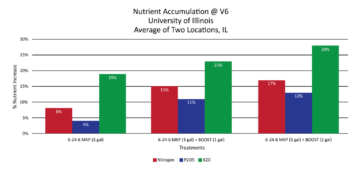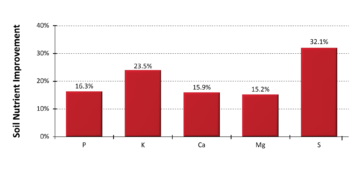Shannon Schumacher, QLF Regional Sales Agronomist, Southeast Minnesota/ North Western Wisconsin
Have you seen purple baby corn plants? You might be observing a phosphorous deficiency in your crop. Purple or dark red leaves on young corn plants is a sign of phosphorous deficiency. Phosphorous is mobile within the plant, and therefore the newest leaves usually won’t show the deficiency symptoms (Sawyer, 2004). Although phosphorous is mobile in the plant, it is not mobile in the soil. Often, soil tests may show sufficient levels of phosphorous in the soil, yet deficiency symptoms are still observed. Soil temperature (Shaw et al, 2020), organic matter, texture, pH, bulk density, other minerals present in the soil, and varying levels of biological activity all effect how much phosphorous plants are able to absorb from the soil. Phosphorous is highly reactive in the soil and will react with different elements, depending on soil pH. Cooler soil temperatures in spring typically inhibit phosphorous uptake by plants.
Some of these factors affecting phosphorous availability to plants are things we can manage, like soil pH and bulk density (compaction). Others, like soil temperature, organic matter, texture, and mineral content are things we need to manage around. Using starter fertilizers to place high quality phosphorous sources close to the seedling gives the plant a greater opportunity to have adequate phosphorous available. Remember, the plant lives mainly off nutrients within the seed until vegetative growth stage V5, where it begins to transition to the below ground nodal root system as the main mechanism for nutrient uptake (Iowa State University, 1993). At this point, because phosphorous is immobile in the soil, it is important to have phosphorus available close to the seed. As stated above, phosphorous is highly reactive in the soil, making it unavailable to the plant (University of Minnesota, 2023). Soil pH between 6.0 and 7.0 will reduce tie up by other nutrients. Warming soil temperatures and proper soil aeration will ensure phosphorous availability by increasing soil microbiological activity. Microorganisms are responsible for solubilizing and mineralizing phosphorous from inorganic and organic pools in soil and making nutrients more plant available (Richardson, 2001). Organisms present in the soil microbial community of the rhizosphere are known to be one of the most influential factors on nutrient availability and plant productivity (Chaparro et al, 2012). Plants communicate with the soil microbial community by releasing different compounds signaling what the plant needs (Zhang et al, 2009). The rapid uptake of plant sugars by soil microorganisms and intensive recycling clearly demonstrates the importance of sugars for microbes in the soil (Gunina et al, 2015). On average, data collected in 2020 and 2021 showed that the addition of an available carbon source stimulated soil microbiology and increased plant available phosphorous levels in the soil by 16.3% (see Martinsville nitrogen trial) and doubling nutrient accumulation in young corn plants (see U of Illinois starter trial).
Ensure your crop has enough phosphorous from an early healthy start and throughout the season this year by monitoring and addressing physical soil characteristics like bulk density or compaction, fixing chemical properties in soil like balancing pH, and improving biological function of soils by supporting a healthy microbiological community. To learn more about how QLF Agronomy can help ensure best results and implement an L-CBF program, Contact your local Regional Sales Agronomist (RSA) today!
Resources:
Chaparro, J.M., Sheflin, A.M., Manter, D.K. 2012.” Manipulating the soil microbiome to increase soil health and plant fertility.” Biol Fertil Soils 48:489–499. https://doi.org/10.1007/s00374-012-0691-4
Geuina, A and Kuzyakov, Y. 2015. “Sugar in soil and sweets for microorganisms: Review of Origin, content, composition, and fate.” Soil Biology and Biochemistry. 90:87-100. https://doi.org/10.1016/j.soilbio.2015.07.021
Iowa State University. 1993. ‘How a Corn Plant Develops”. Iowa State University of Science and Technology. Retrieved Mar. 2, 2023. https://www.soilcropandmore.info/crops/Corn/How-Corn-Grows/#summary
Richardson, AE. 2001. “Prospects for using soil microorganisms to improve the acquisition of phosphorous by plants.” Australian Journal of Plant Pathology. 28-9:879-906. https://www.webofscience.com/wos/woscc/full-record/WOS:000171163000008
Sawyer, John. 2004. “IMP: Nutrient Deficiencies and Application Injuries in Field Crops.” Iowa State University Extension. Retrieved Mar. 2, 2023. chrome-extension://efaidnbmnnnibpcajpcglclefindmkaj/https://crops.extension.iastate.edu/files/article/nutrientdeficiency.pdf
Shaw, A.N., Cleveland, C.C. 2020. “The effects of temperature on soil phosphorus availability and phosphatase enzyme activities: a cross-ecosystem study from the tropics to the Arctic.” Biogeochemistry 151:113–125 https://doi.org/10.1007/s10533-020-00710-6
University of Minnesota. 2023. “Phosphorous Cycle”. Southwest Research and Outreach Center. Retrieved Mar. 3, 2023. https://swroc.cfans.umn.edu/research/soil-water/phosphorus-cycle#:~:text=Phosphorus%20reactions%20in%20soil%20are,form%20low%20solubility%20Ca%20phosphates.
Zhang, Huiming, Sun, Yan, Xie, Xitao, Kim, Mi-Seong, Dowd, Scot E, and Pare, Paul W. 2009. “A soil bacterium regulates plant acquisition of iron via deficiency-inductible mechanisms”. The Plant Journal. 54-8:541-714. https://doi.org/10.1111/j.1365-313X.2009.03803.x




